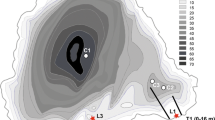Abstract
Spatial and temporal heterogeneity of recent diatom stratigraphy were assessed for a small (23 ha) dimictic lake in Northern Sweden (Kassjön). Varves are confined to water depths > 10 m. Six freeze cores were taken along a transect covering a range of water depths (3–12 m) and both varved and non-varved sediments. Core profiles were compared for dry mass accumulation, loss-on-ignition (LOI), and diatom relative frequency stratigraphy and accumulation rate. Excluding the 3.2 m water depth, non-varved core, all parameters showed good repeatability between cores, apart from diatom accumulation rates which were more variable. The 3.2 m core was atypical and had lower LOI values, low planktonic diatom percentages and high values of benthic taxa that were not abundant in the deep-water sediments. Detrended Correspondence Analysis (DCA) and Canonical Correspondence Analysis (CCA) ordinations were compared; both methods clearly differentiated the shallow water core, and showed the general similar ecological trends of the deeper-water cores. CCA axes constrained by “environmental” (i. e. core location) data resulted in slightly lower eigenvalues than that obtained by Correspondence Analysis (CA), but the axes were significantly non-random. A Partial-CCA of the four varved cores alone (with effects of sediment depth, i.e. age, partialled out), indicated that there was no significant difference between their diatom assemblages.
Similar content being viewed by others
References
Anderson, N. J. 1986. Diatom biostratigraphy and comparative core correlation within a small lake basin. Hydrobiologia 143:105–112.
Anderson, N. J. 1989. A whole-basin diatom accumulation rate for a small eutrophic lake in Northern Ireland and its palaeoecological implications. J. Ecol. 77:926–946.
Anderson, N. J. 1990a. Variability of diatom concentrations and accumulation rates in sediments of a small lake basin. Limnol. Oceanogr. 35:497–508.
Anderson, N. J. 1990b. Variability of sediment diatom assemblages in an upland, windstressed lake (Loch Fleet, Galloway, S. W. Scotland). J. Paleolimnol. 4:43–59.
Anderson, R. Y., W. E. Dean, J. P. Bradbury, and D. Love. 1985. Meromictic lakes and varved lake sediments in Nort America. U. S. Geological Survey Bulletin 1607.
Anthony, R. S. 1977. Iron-rich rhythmically laminated sediments in Lake of the Clouds, northeastern Minnesota. Limnol. Oceanogr. 22, 45–54.
Battarbee, R. W. 1978. Biostratigraphical evidence for variations in the recent pattern of sediment accumulation in Lough Neagh, Northern Ireland. Verh. Internat. Verein. Limnol. 20:625–629.
Battarbee, R. W. 1986. Diatom analysis, in Berglund, B. E. (ed.) Handbook of Holocene Palaeoecology and Palaeohydrology. Chichester, J. Wiley, pp: 527–570.
Battarbee; R. W. and M. J. Kneen. 1982. The use of electronically counted microspheres in absolut diatom analysis. Limnol. Oceanogr. 27:184–188.
Birks, H. J. B. 1987. Multivariate analysis of stratigraphic data in geology: a review. Chemometrics 2:109–126.
Bradbury, J. P., and T. C. Winter. 1976. Areal distribution and stratigraphy of diatoms in the sediments of Lake Sallie, Minnesota. Ecology 57:1005–1014.
Charles, D. F., S. S. Dixit, B. F. Cumming and J. P. Smol. 1991. Variability in diatom and chrysophyte assemblages and inferred pH: paleolimnological studies of Big Moose L., (N. Y., U. S. A.) J. Paleolimnol. 5:267–284.
Cumming, B. F. (and others) 1992). How much acidification has occurred in Adirondack region lakes (New York, USA) since preindustrial times? Can. J. Fish. Aquat. Sci. 49:128–141.
Dearing, J. A. 1986. Core correlation and total sediment influx. In. B. E. Berglund (ed.) Handbook of Holocene Palaeoecology and Palaeohydrology. Chichester, J. Wiley pp: 247–270.
Downing, J. A. and Rath, L. C. 1988. Spatial patchiness in the lacustrine sedimentary environment. Limnol. Oceanogr. 27:137–150.
Kristensen, P., Søndergaard, M. and Jeppesen, E. 1992. Resuspension in a shallow eutrophic lake. Hydrobiologia 228:101–109.
Leavitt, P. R., and Carpenter, S. R. 1989. Effects of sediment mixing and benthic algal production on fossil algal stratigraphies. J. Paleolimnol. 2:147–158.
Murchie, S. L. 1985.210Pb dating and the recent geologic history of Crystal Bay, Lake Minnetonka, Minnesota. Limnol. Oceanogr. 30:1154–1170.
Nipkow, H. F. 1928. Über das Verhalten der Skelette planktischer Kieselalgen im geschichteten Tiefenschlamm des Zürich- und Baldeggersees. Zeits für Hydrologie IV, 71–120.
Renberg, I. 1978. Palaeolimnology and varve counts of the annually laminated sediment of Lake Rudetjärn, Northern Sweden. Early Norrland 11:63–92.
Renberg, I. 1981a. Formation, structure and visual appearance of iron-rich, varved lake sediments. Verh. Internat. Verein. Limnol. 21:94–101.
Renberg, I. 1981b. Improved methods for sampling, photographing and varve-counting of varved lake sediments. Boreas 10:255–258.
Segerström, U. 1990. The natural Holocene vegetation development and the introduction of agriculture in Northern Norrland, Sweden. Studies of soil, peat, and especially varved lake sediments. Ph.D thesis University of Umeå.
Segerström, U., Renberg, I. and Wallin, J.-E. 1984. Annual sediment accumulation and landuse history; investigations of varved lake sediments. Verh. Internat. Verein. Limnol. 22:1396–1403.
Simola, H. 1977. Diatom succession in the formation of annually laminated sediments in Lovojarvi, a small eutrophic lake. Ann. Bot. Fenn. 14:143–148.
ter Braak, C. J. F. 1986. Canonical correspondence analysis: a new eigenvector technique for mulitvariate direct gradient analysis. Ecology 67:1167–1179.
ter Braak, C. J. F. 1987. CANOCO — a FORTRAN program for canonical community ordination by (partial) (detrended) (canonical) correspondence analysis, principal components analysis and redundancy analysis (version 2.1). TNO Institute of Applied Computer Science, Wageningen.
ter Braak, C. J. F. and Prentice, I. C. 1988. A theory for gradient analysis. Adv. Ecol Res. 18:271–317.
Author information
Authors and Affiliations
Rights and permissions
About this article
Cite this article
Anderson, N.J., Korsman, T. & Renberg, I. Spatial heterogeneity of diatom stratigraphy in varved and non-varved sediments of a small, boreal-forest lake. Aquatic Science 56, 40–58 (1994). https://doi.org/10.1007/BF00877434
Received:
Accepted:
Issue Date:
DOI: https://doi.org/10.1007/BF00877434




